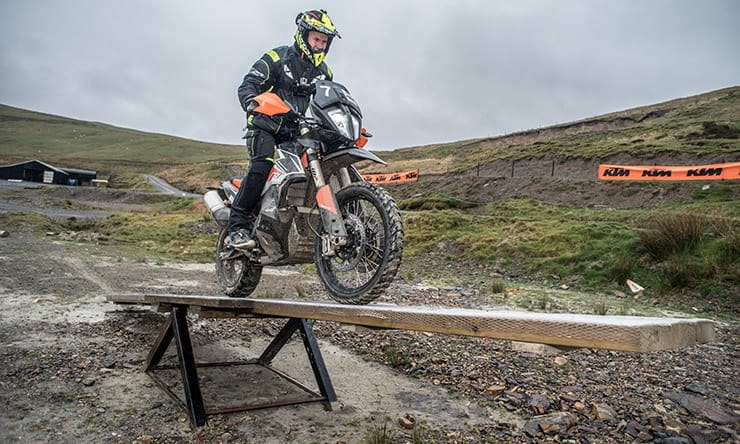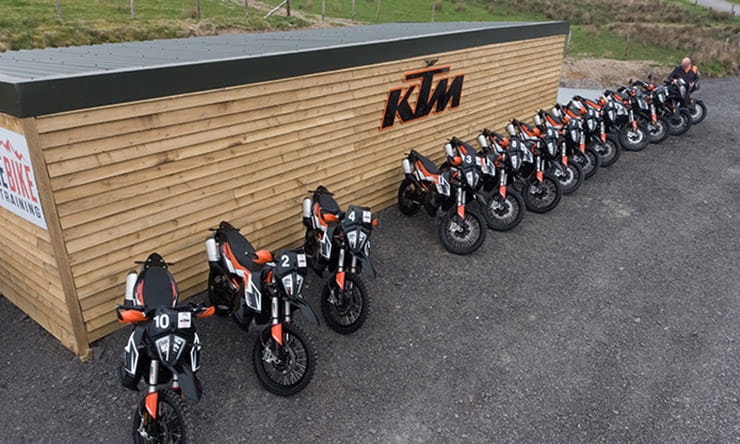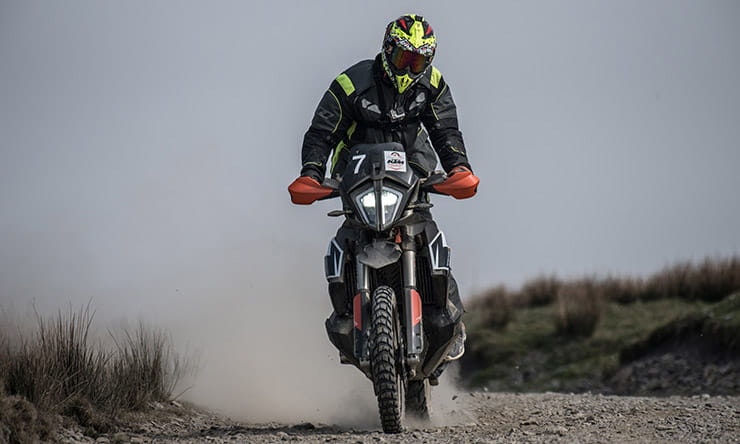Tested: Sweet Lamb KTM Adventure Experience review
By Kane Dalton
BikeSocial's former Commercial Manager
03.05.2019
KIT CREDITS
Boots
Alpinestars Tech 10 - £489.99
https://www.getgeared.co.uk/2019-alpinestars-tech-10-mx-boots-white
Date reviewed: April 2019 | Tested by: Kane Dalton | Price: £530 (two-day course) | Website: https://ktm.adventurerallybike.co.uk/
In deepest central Wales, there lies the Sweet Lamb KTM Adventure Experience, a school owned and operated by KTM that shares both the stunningly scenic and equally as rural parts of the country with several other adventure bike manufacturers and their own respective schools.
KTM run two-day tiered courses structured as bronze, silver, orange and orange pro and are tailored to the rider’s ability. They provide the foundations to build to the next level and riders can repeat levels if they feel the need before moving forward. All you’ll need is a bike licence and your own riding gear to attend the school.
While the Austrian firm are not new to the adventure market, their school and facilities are. 12 training areas ranging from half a mile to 20 miles sit within the total of 6,600 acres of breath-taking landscape with epic vista views beyond. Sweet Lamb is well established in off-road circles as it is the home to many of stages in the Wales Rally GB.
Here’s a little taster of what to expect when we attended the media day:
Tested: Sweet Lamb KTM Adventure Experience review
Testing the KTM 790 Adventure R at KTM’s own Sweet Lamb Adventure bike school, based in Aberystwyth Wales.
What you’ll learn
Each level is a two-day course. It doesn’t matter if you are an off-road beginner or have some miles under your belt because the instructors assess each rider and cater for individuals on each course – novices can tackle easier tracks and those with more experience can take on tougher tasks. A maximum of 12 riders per group are taught by two instructors and one of those is Mark ‘Molly’ Molineux – the ACU and MCF qualified chief instructor who’s owned more than 135 motorcycles and covered over 1,000,000 miles on the road. He has a relentless passion for off-road riding with experience in motocross, enduros, trails, rallies, desert riding and track days... and says he still can’t get enough.
The modular course structure means that each course builds on the previous version. It also means you get the opportunity to return to the school as many times as you want!
Each course starts with a welcome and safety briefing held in a lovely Swiss style log cabin equipped with tea, coffee and a warm changing area. Lunch is taken at a glamping style bivouac tent.
The days riding begins with a warm-up ride and rider assessment allowing for any nerves to settle and for the instructors to assess how they’ll tailor the course.
Skills training is broken up by food and hydration breaks with a debrief at the end of each days riding.
Above: picturesque Welsh countryside, warm changing area
Course Description
Bronze
Foundation skills
Bike familiarity
Balance (Cone Work)
Lifting from the ground safely
Starting away
Feet up / pull aways
Correct head position
Correct Stance
Gravel rod
Brake/throttle/clutch/control
Rear brake familiarity and it’s uses
Read and ride trails
Silver
A focus on developing the technical aspects of Adventure Bike riding, while introducing new obstacles and situations to master. An introduction to new terrain and the first stage of advanced skills like Preloading and Power Turns.
Downhills
Ascents
Hill recovery
Back brake skills
Loading Pegs
Ruts
River crossing & recovery
Pre – Load stage 1
Gravel tracks
Vanishing point
Power Turns stage 1
Orange
An introduction to higher levels of bike control. Orange tackles more challenging terrain and develops a deeper understanding of Bike control.
Power Slides – stage 2
Brake turns
Front brake technique
Aggressive hills
River crossings
Jumps
Loading suspension
Preload – stage 2
Rock gullies
Steep drops- offs
Steep uphills
Berm riding
Orange Pro
You have the know-how, now learn why and when to use your skills. A move on to competition riding
How to ride at speed and master a rally pace
When to use the brake turns and power slides
Why and when should you load the suspension
Why and when would you choose to jump over an obstacle instead of riding around it
How to master ruts
How and when to ride a berm corner
Choosing the correct lines best suited to your riding style
Trail interpretation: the faster you can read and interpret the trail, the faster you can choose the safe line
Adventure riding skills to conserve energy
Above: ‘Molly’, his band of happy students and their playground
Who’s it aimed at?
The courses are aimed at riders of all ability whether you’re stepping onto an off-road bike for the first time through to those looking to hone their already –awesome gnarly skills. The content of all courses should lead to significant benefit when transferred directly to road riding.
You could be new to riding or planning your Dakar application, I have learned the hard way that learning from others with vast amounts of experience is always most useful.
In real-world situations, we spend at least 80% of the time riding on the road, often to find each little piece of off-road heaven and, more often than not, the bike will have a pillion and/or luggage. So, when we’re riding in a remote area what do you do when you drop your pride and joy or have to negotiate a water crossing? Obstacles, deep mud, lose rock, sand, steep up and downhill tracks all pose their own challenges. Do you get stuck or try and figure it out as you go? If you have learned techniques and practicing them in a controlled safe environment you will be better off dealing with these things where there may be no help on hand.
Above: Mazes, water and massive jumps; the key to enjoying off-roading
What I got out of it
My day at Sweet Lamb was only a condensed taster version of the what the school has to offer. After the safety briefing and the outlined plan of the day, we’re introduced to the KTM 790 Adventure R and its controls including engine modes and traction settings.
First up, an easy gravel road ride to the first assessment area; a large loop.
The instructors rode between the group to see what the level of experience was. For some it was completely new, a couple of people had ridden some enduro many years before but not been off-road for some time, and few were up-to-date with recent enduro and large adventure bike riding experiences. It really was a mixed bag. Initially, it was clear to see the differences from how comfortable riders looked yet as the day progressed everyone started to look and feel more confident and comfortable on the bikes.
We moved from the gravel road to dusty trails with lose shale and rock. This was more technical to ride but still fairly easy and a nice way to get the ‘sea legs’ back, or should I say ‘off-road legs’.
Earlier this year I spent two weeks riding off-road in Morocco over all sorts of terrain. I found that when I was riding on sand roads that were split into deep narrow ruts by the cars and trucks, the edge of the ruts were really slippery. If you never stayed on your line the bike would wash out sideways really quickly. If you pick up your speed then this becomes even more of a challenge.
I felt far more comfortable on a more open piste, however this brings its own challenges. You have to focus, look and plan far enough ahead. I find reading what is in front of you and being able to read and react quickly is the only way you can pick up the pace and keep safe at the same time.
Molly, our instructor for the day had a great bit of advice that will stick with me, “keep your head up and look out of trouble”. I have to talk out loud to myself on track when I am running wide and the kitty litter is looming, I shout to myself – don’t look at the kitty litter! Don’t look at the kitty litter!
Riding at mid pack rally pace on the tracks in Morocco and wanting to stay in the track meant I had to be precise and had to turn the bike quickly where it was needed. Easier said than done, I assure you. I said earlier that it’s always going to be useful getting expert tuition and my Morocco experience would have been much easier if I’d have been to Sweet Lamb beforehand.
Molly gave us drills practicing weighting the pegs - towards the side of the turn made the bike turn with precision. Yet counter balancing by putting my body on the opposite side of the bike. (this is completely opposite to road riding), and I could immediately see and feel the difference in turns.
As we got to grips with the drill we moved onto riding in large circles a little over walking pace. This drill and skill is all about slow speed stability. After doing the large circles we closed then down to smaller ones and turning the bike on full lock. This incorporated weighting the inside peg, counter balancing with your body, clutch control and using the rear brake. This progressed to riding full lock figure of eights.
Molly explained about the hours spent practicing these drills, slow speed manoeuvring and changing direction on the courses. The skills are most useful for negotiating tight lines and helps with balance, when you are riding in deep ruts or gullies this is fundamental.
Above: Grown-up playtime
We were then allowed to play on the humps and mini jumps on the skills course. I say jumps but it was all about smooth control up and over. There were also logs and tyres set upright to practice riding over. The weather had changed it was raining now meaning that jumping over wet logs takes some commitment and planning.
One obstacle is a narrow elevated concrete slab. Usually on the road or a trail if you look ahead and ride in a straight line it’s pretty easy. When you throw in a wet elevated concrete slab and asked to do the same thing it makes things a little bit more tricky, psychologically. The slab is only about two feet off the ground but enough to stress you. You naturally want to look down which makes you feel unstable so the key is to keep your head up and looking further ahead it is easy.
There were a number of slow speed technical exercises which were so much fun. We never had enough time to really get to grips with all of them but the KTM courses run over two days so there’s plenty more opportunity.
My personal favourite of the day was riding over a seesaw - a plank with a 3ft high pivot in the middle. Riding up to and over the pivot with a pause in the middle for the plank to pivot before riding down and off takes some skill because if you lose your balance at the top it’s a fairly long drop to the floor. So there’s a great incentive to keep everything under control.
After the skills exercises and lunch we did some more wet slippery trails and a river crossing. The trail was obscured by rain and fog, we were told that the path had quick changes in direction in places with drop off on the side meaning an alteration to the riding focus we’d be taught earlier. Instead, it had to be riding what we could see and not what we thought was ahead. This is a great exercise and something worth doing.
I learned this lesson in Morocco too, you often tend to think that you have right of way and don’t expect anyone else on a trail. This is especially true in remote areas and probably the place that you are most at risk. I was following another rider into a blind bend in the Sahara, we both took a wide entry point to the corner and as we did we were faced with a dune buggy been driven by a tourist joyrider he thought he was the only person for a hundred miles. We both narrowly missed a serious accident.
The brief before entering the water was always to err on the side of caution in water. You never know what lies beneath or how deep any water can be. There could be a strong current that would affect the crossing. However, as this was also a photo opportunity once the first person had cleared the water it became more of a water splash competition.
Above: the catalogue shot
How does it relate to road riding?
As mentioned, I’m the kind of person that tends to learn things my own way at my own pace and haven’t been one for formal training of any kind. I’ve mostly ridden on the road for the last 30 years but more recently exploring more off-road riding with large adventure bikes, enduro and flat track.
I’ve always focussed on grip levels this was especially true with road racing yet riding off-road has helped me deal with things like lose gravel on the road better and moving out of my natural tendency to grab a handful of brake.
Off-road riding on all surfaces and conditions, both dry and wet gives you more the confidence and skills to deal with these hazards. Planning ahead on the gravel needs to be far in advance and I’ve been able to move away from the habit of looking immediately in front of the front wheel.
If you take speed out appropriately and early enough you will be a safer rider and these skills transfer directly to the road. Remember, “only ride and trust what you can see.”
I have been inspired to want to go back to school and learn what others took many years to learn. Taking fundamental basics and the building on them can only make me a better more aware and skilful rider.


